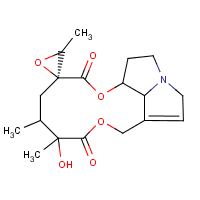Jacobine
Agent Name
Jacobine
CAS Number
6870-67-3
Formula
C18-H25-N-O6
Major Category
Biological Agents

Synonyms
(15alpha,20R)15,20-Epoxy-15,20-dihydro-12-hydroxysenecionan-11,16-dione; 12beta-Hydroxy-12alpha,13beta-dimethylsenec-1-enine-15S-spiro-2'-(3'R-methyloxiran); 15,20-Epoxy-15,20-dihydro-12-hydroxysenecionan-11,16-dione; Senecionan-11,16-dione, 15,20-epoxy-15,20-dihydro-12-hydroxy-, (15alpha,20R)-; [ChemIDplus]
Category
Plant Toxins
Description
Colorless solid; [HSDB]
Sources/Uses
Used as a medicinal herb in Europe; [HSDB]
Comments
An hepatotoxic alkaloid present in tansy ragwort (S. jacobaea) and in the honey produced from the nectar of this plant; [HSDB] Hepatotoxic pyrrolizidine alkaloids are produced by tansy ragwort (Senecio spp); [Olson, p. 388] Over 6000 plants produce pyyrolizidine alkaloids, some of which are toxic. This is probably the most common plant toxin, and it affects livestock, wildlife, and humans. [Haddad, p. 494] Mechanism of toxicity is the metabolic conversion into pyrroles that act as alkylating agents. Hepatic disease leads to cirrhosis and possibly increased risk for hepatic carcinoma. Most poisoning cases have resulted from contamination of food grain with the seeds containing the alkaloid or from medicinal herbs. An estimated 20% of patients die, 50% recover completely, and 30% develop chronic hepatic veno-occlusive disease. [Goldfrank, p. 647, 1546]
Biomedical References
Exposure Assessment
Vapor Pressure
9.3E-13 mm Hg
Adverse Effects
Hepatotoxin
Hepatoxic (a) from occupational exposure (secondary effect) or (b) in animal studies or in humans after ingestion
IARC Carcinogen
Not classifiable
Diseases, Processes, and Activities Linked to This Agent
Activities
Activities with risk of exposure: